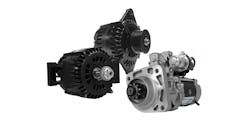To make hybrid technology even more viable for commercial vehicles - especially for Class 8 trucks - it‘s all going to come down to the batteries. They are the make-or-break lynchpin for hybrid vehicle growth in the commercial market.
Develop a battery that‘s lighter and can hold more electricity for longer intervals between re-charging - as well as one that can do double-duty by not only helping propel the vehicle but also providing power for heating, cooling, and other onboard needs - and hybrid systems will really catch fire with fleets.
So, what kind of battery will fit that bill? We know tried-and-true lead-acid batteries are just too heavy and don‘t hold enough juice. Lithium-ion seems to be the frontrunner, but there‘s a spate of other technologies out there, too, such as absorbed glass mat (AGM) batteries, which are getting close attention for anti-idling systems.
And things are moving fast in the battery arena. In an effort to jump-start the mass production of lithium-ion batteries, Nissan Motor Co., fellow Japanese firm NEC Corp. and subsidiary, NEC Tokin Corp., formed a special joint-venture company in April last year called Automotive Energy Supply Corp. (AESC). Nissan said it expects the joint venture to begin mass-producing lithium-ion batteries for vehicle applications by 2009.
Milwaukee, WI-based Johnson Controls-Saft Advanced Power Solutions (JCS) got the green light in 2006 to start work on developing longer-life lithium-ion batteries for hybrids, part of a 24-month contract partially funded by the U.S. Advanced Battery Consortium (USABC), a group that includes the Dept. of Energy, Daimler AG, Ford and General Motors.
Then there‘s the new joint venture between truck maker Paccar and component supplier Eaton Corp. to develop a Class 8 hybrid truck by 2009. Eaton is providing the hybrid drivetrain system -- a traction motor married to a Fuller UltraShift 10-sp. automated transmission and four lithium ion batteries -- while Paccar subsidiaries Kenworth and Peterbilt provide the chassis, diesel engine and engineering assistance to integrate everything.
(For a video report on Paccar's Class 8 hybrid, developed with Eaton, click on the link below.)
Paccar's Class 8 hybrid prototype
Todd Graham, Eaton‘s account manager for Peterbilt, explained to me last August that hybrid technology would only add about 300 lb. to a Class 8 tractor, mainly from the traction motor and power electric carrier (PEC), which holds four lithium ion batteries and replaces the standard batteries normally used to power the starter. Eaton is shooting for a five-year life cycle for the lithium ion batteries, he added.
Eaton‘s heavy-duty hybrid electric power system will be built using an automated manual transmission with a parallel-type “direct” hybrid system, incorporating an electric motor/generator located between the output of an automated clutch and the input to the transmission.
One benefit of this approach, Graham told me, will be that braking energy captured and then stored as electric energy in the batteries can be used to provide torque from the electric motor and blended with engine torque to improve vehicle performance, operate the engine in a more fuel-efficient range for a given speed, or run the truck with electric power only, said Graham.
The other trick here is to make sure the batteries used on a Class 8 hybrid can withstand trucking‘s at-times extremely harsh operating environment. That‘s the challenge John Duffy, Kenworth‘s manager of advanced technology, faced when developing factory-built battery-based auxiliary power units (APUs) on his company‘s trucks, know as the “Clean Power” system.
“We deliberately developed our Clean Power System to run on batteries to totally eliminate any issues with emissions,” he told me during a special ride and drive held at the Paccar Technical Center in Mount Vernon, WA, last year.
“The first stage of that challenge is to improve the efficiency and life cycle of a battery-powered system operating in the harsh environment of trucking,” said Duffy. “The bar we have to meet as an OEM is much higher in terms of reliability and durability, since we are the ones putting this into the vehicle. The actual concept of integrating an all battery-powered APU into a Class 8 tractor took just six months; the other 18 months were spent hardening it.”
Duffy feels that the battery-powered APU not only allows the vehicle to burn less fuel but also to stay ahead of state or local diesel emission restrictions. He said the system uses roughly a gallon‘s worth of fuel to be fully recharged by the truck‘s engine over the course of the day and consumes energy at about 1/10th of a gallon per hour, compared to 3/10th to 5/10th of a gallon per hour of a traditional diesel-fired APU.
It‘s a tricky issue, developing batteries that can do all of this yet be as cheap as possible so the price tag to truckers doesn‘t get too extreme. But we‘ll be seeing the fruits of all that research very soon, I expect.



